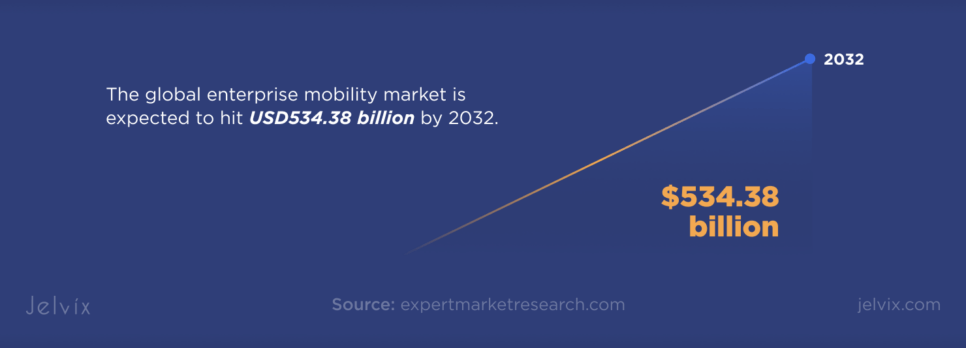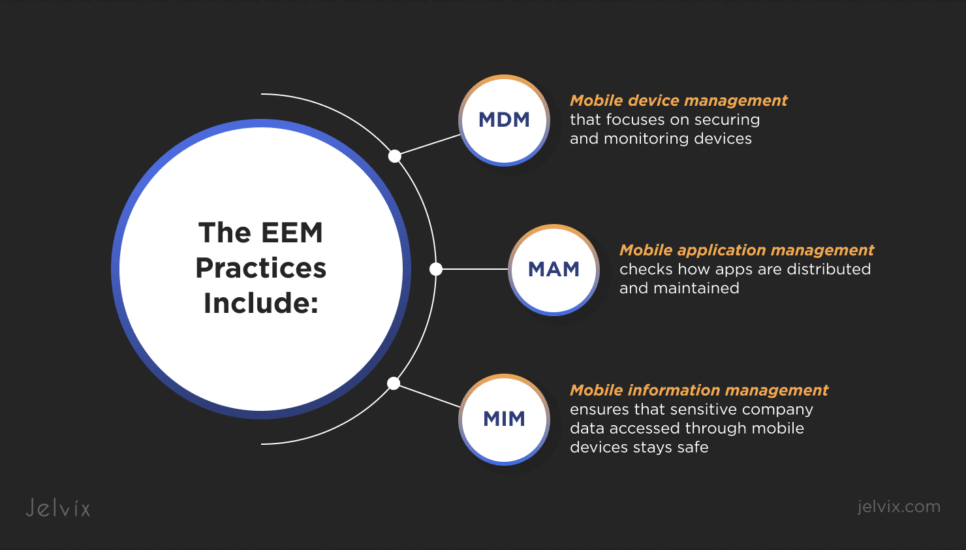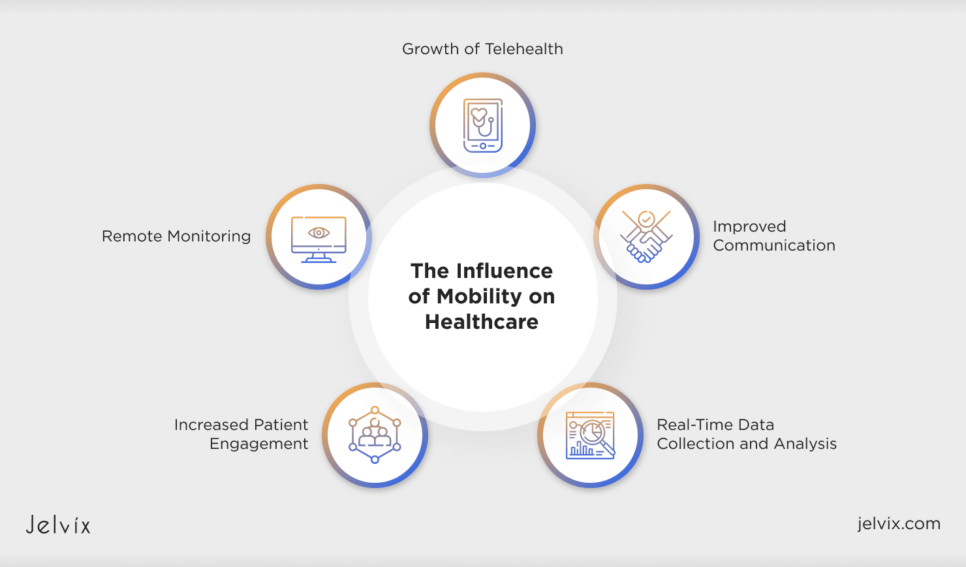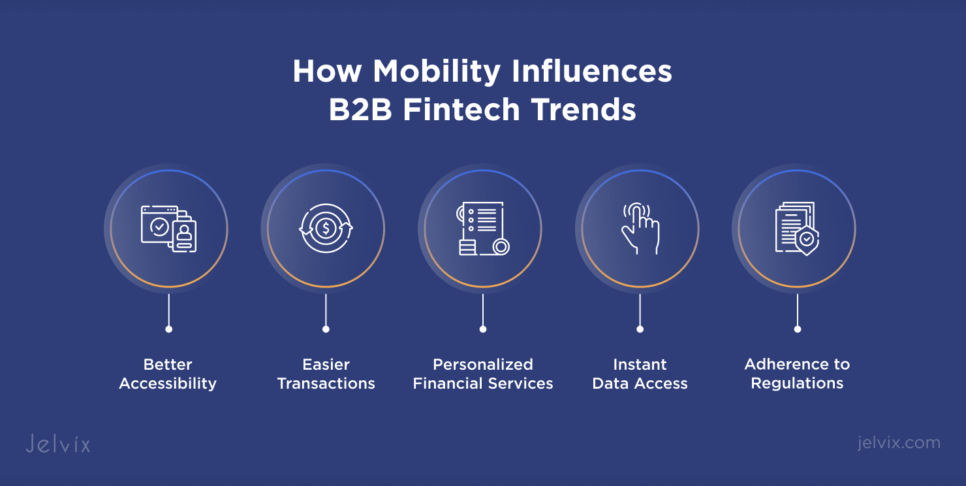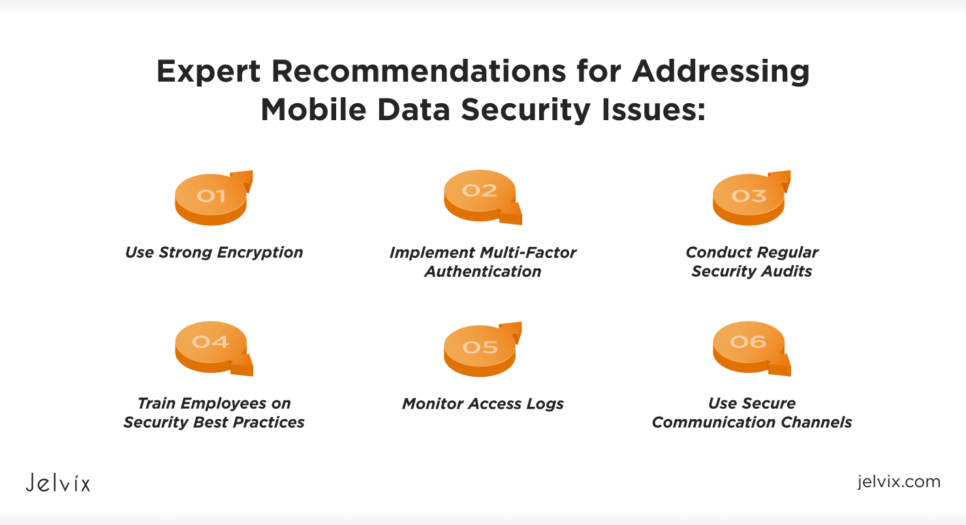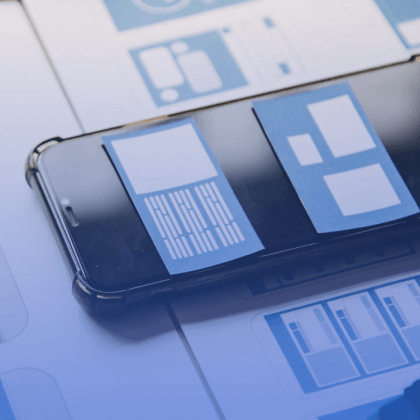As customer demands grow, global businesses prioritize flexibility in how they deliver services. The survival of enterprises, now, depends on their ability to be present in real time, and mobile solutions help address this need.
The global enterprise mobility market is expected to hit USD534.38 billion by 2032. It means, more businesses adopt mobility, and those who neglect this tendency risk to pull out from the competition.
If you want to learn more about the upcoming mobility trends and their impact on your niche, keep reading. We’ll explore what enterprise mobility means, its impact on healthcare and fintech, and what the future holds as we approach 2025.
What Is Enterprise Mobility?
The ability of businesses to adapt their workflows to remote environments is called enterprise mobility. It denotes how flexible companies are when they need their workers to use remote devices, such as mobile phones and laptops, to get the job done.
The need for enterprise mobility is generally driven by tech trends and users who demand more flexibility in accessing services they used to get offline. For instance, getting banking services was the third key reason to access a smartphone between 2022 and 2023 (after chatting and sending emails).
It means that mobility becomes something enterprises can’t survive without, and implementing new tech can not just help them stay competitive but also cut costs and improve their productivity.
Enterprise Mobility Management Explained
Enterprise mobility, however, can exist on its own and require strict guidance to get implemented. In turn, enterprise mobility management is a set of strategies that help manage the use of mobile devices inside of an enterprise correctly.
The EEM practices usually include:
- MDM: mobile device management that focuses on securing and monitoring devices;
- MAM: mobile application management checks how apps are distributed and maintained;
- MIM: mobile information management ensures that sensitive company data accessed through mobile devices stays safe.
Of course, EEM changes along with tech trends. Modern EEM, for instance, needs to include features like secure cloud storage, quick access to data, and advanced analytics. This is where UEM (unified endpoint management) can help. It extends the capabilities of EMM by providing a comprehensive approach to managing all endpoints from a single platform. By implementing effective EMM and UEM strategies, companies can improve their operations and stay competitive in a fast-changing business world.
Let's find out what is native application and cross-platform mobile application and what is a difference.
How Enterprise Mobility Trends Impact Key Industries
It’s pretty difficult to find a sector that wasn’t impacted by digitalization and that hasn’t experienced the shift toward enterprise mobility. Thanks to mobile trends, sectors like healthcare and fintech can expand their services and offer new ways of interacting with their solutions.
The Influence of Mobility on Healthcare
The global market for healthcare mobility solutions is expected to reach USD286.7 billion by 2030. These solutions make a huge impact on healthcare, changing how medical professionals deliver care and manage their work.
Growth of Telehealth
Medical cloud computing made it possible to provide secure telehealth services even in remote areas. However, enterprise mobility made it truly popular thanks to the accessibility the mobile device brings to the population. What’s more, enterprise mobility ensures real-time communication between patients and healthcare providers.
Improved Communication
Mobile devices also help to reduce the gap in communication between medical professionals. Thanks to the ability to share information right here and now, doctors and nurses can exchange data through secure messaging apps making the treatment process more efficient.
Real-Time Data Collection and Analysis
Mobile technologies make it simple to collect and analyze data. Healthcare pros can use mobile apps to gather patient feedback, track health metrics, and monitor outcomes, which helps them make better decisions and continuously improve care quality.
Increased Patient Engagement
Patients are becoming more involved in their healthcare thanks to mobile apps that give them access to health information, appointment reminders, and educational resources. This empowerment encourages them to take an active role in managing their health.
Remote Monitoring
Wearable devices and health apps allow doctors to monitor patients’ vital signs and health conditions remotely. This ongoing monitoring can lead to early detection of problems and prompt interventions, improving patient outcomes.
How Mobility Influences B2B Fintech Trends
Enterprise mobility adoption also changes current trends in fintech by improving accessibility, simplifying transactions, and enhancing customer engagement.
Better Accessibility
Banking has always been complicated, but thanks to mobile devices people can control their funds right from home. Managing money isn’t a problem anymore, as clients can check out their balance and send money to one another with a few taps on their phones.
Easier Transactions
Financial entities actively implement mobile solutions to make payments easier and faster. Their clients can use digital wallets to save and manage money, one-click payments to make transitions faster, and P2P transfers to make transactions easy for everyone.
Personalized Financial Services
With the help of artificial intelligence and machine learning, mobile apps can analyze user habits and preferences to offer tailored financial advice and product suggestions. This personalization makes it easier for customers to find the right financial solutions that suit their needs, leading to higher satisfaction.
Instant Data Access
Mobile technologies allow users to access their financial information in real-time. This quick access helps customers make better decisions, whether they need to track spending or monitor investments.
Adherence to Regulations
Enterprise mobility helps clinics comply with regulations by providing strong security features that protect sensitive patient information. For example, mobile solutions use encryption and secure access controls to ensure that only authorized users can view data, successfully meeting such requirements as HIPAA.
The Future of Enterprise Mobility: Trends for Healthcare and Fintech To Expect in 2025
Managed mobility services valued over USD14 billion in 2022. As we look ahead to 2025, several exciting enterprise mobility trends are expected to change the game for the healthcare and fintech industries.
Widespread Adoption of 5G Technology
The rollout of 5G networks will transform mobile connectivity. In healthcare, this technology will allow medical professionals to access patient data and records instantly, leading to quicker and better decision-making. In fintech, 5G will make transactions smoother and enable faster data processing, improving the overall user experience.
Increased Integration of Artificial Intelligence
AI will become even more integrated into mobile applications across both sectors. Conversational AI in healthcare will help provide personalized treatment suggestions and insights. What’s more, predictive analytics will be widely used for preventive care. In fintech, AI will enhance fraud detection, optimize risk assessments, improve credit scoring, and enhance customer service through smart chatbots and virtual assistants.
Enhanced Interoperability
There will be a strong focus on ensuring that mobile technologies can easily work with existing systems, especially in healthcare. This means mobile apps will be able to communicate effectively with EHRs, allowing for a smooth flow of information. In fintech, better interoperability will help integrate various financial services and platforms, making it easier for users to manage money.
Focus on User-Centric Design
User experience will take priority as healthcare and fintech applications become more user-friendly and visually appealing. This will help customers use apps with ease, making it simpler for them to access services and manage their finances or health information.
Security Measures
As reliance on mobile solutions grows, security will become a top priority. Both healthcare and fintech organizations will implement advanced security features to protect sensitive customer data and build trust.
Expansion of Remote Services
Telehealth will continue to grow, allowing patients to connect with doctors remotely through mobile technology. In fintech, remote financial services will become more common, letting customers manage their finances easily from anywhere without needing to visit a bank.
Data-Driven Decision Making
The use of data analytics will play a vital role in both industries. Healthcare organizations will collect and analyze patient data using mobile technologies, leading to better treatment outcomes and increased efficiency. In fintech, data insights will inform personalized services and marketing strategies, giving companies a clearer understanding of their customers’ needs.
Sustainability Initiatives
Both sectors will increasingly focus on sustainability in their mobility strategies. This includes using mobile technologies to reduce paper waste, optimize resources, and improve overall business efficiency. As consumers become more environmentally conscious, organizations that prioritize sustainability will have a better competitive edge.
Integrating Mobility into an EHR Solution for Real-Time Patient Updates
To fully use the benefits of mobile technologies in healthcare, these tools must work seamlessly with EHR systems. This connection will provide real-time updates on patient information, which can greatly enhance the quality of care.
Offline Functionality
Integrating offline functionality allows healthcare providers to input data even when Internet access is unavailable. This ensures that important data can still be recorded and later synced when connectivity is restored, improving the efficiency and reliability of patient care.
Quick Access to Patient Information
Mobile apps allow doctors to quickly access patient records stored in EHR systems and find important details, such as medical histories, allergies, and treatment plans. This accessibility can result in better health-related decisions and improved patient outcomes.
Instant Notifications
When mobile technologies are linked to EHR systems, healthcare professionals can receive immediate alerts about important patient updates. For example, if lab results come in, mobile apps quickly show this information, ensuring that medical staff is informed and ready to act.
Easy Data Entry
Healthcare providers should be able to enter patient data directly into EHR systems using their mobile devices. This allows them to document patient interactions, treatment notes, and observations on the spot, reducing paperwork and keeping records up-to-date.
Patient Engagement
Integrating mobile technologies with EHRs can also give patients access to their health information through mobile apps. Patients can receive timely reminders about appointments, lab results, and medications, taking an active role in their health management.
Data Insights and Analysis
Mobile applications that connect with EHR systems can use data analytics to monitor patient outcomes and improve efficiency. This information provides valuable insights that help healthcare professionals identify health trends and enhance care delivery.
Discover the key differences between custom and off-the-shelf EHR solutions to find the best fit for your practice’s needs.
The Future of Electronic Health Records: Addressing Data Security Issues Related to Mobility
Although the integration of mobile devices can bring significant benefits to healthcare, it can create vulnerabilities if not managed properly. The Jelvix team recommends that you consider several strategies to address potential data security issues.
Use Strong Encryption
Encryption is like a protective lock for patient information. By encrypting data both when it’s stored and while it’s being sent, organizations can prevent unauthorized access. Even if someone intercepts the data, it will be unreadable without the right key.
Implement Multi-Factor Authentication
MFA adds an extra layer of security to medical apps. It requires users to provide two or more ways to verify their identity, like a password plus a fingerprint or a one-time code sent to their phone. This makes it much harder for someone to gain unauthorized access to EHR systems.
Conduct Regular Security Audits
Regular security audits are needed to identify vulnerabilities and ensure compliance with laws and regulations. Audits help companies evaluate their security measures, uncover weaknesses, and make improvements to protect sensitive data.
Train Employees on Security Best Practices
Educating staff about data security can help prevent breaches. Employees should learn how to recognize phishing attempts, create strong passwords, and follow proper procedures when handling patient data. Regular training sessions help keep security top of mind and encourage a culture of vigilance.
Monitor Access Logs
Keeping an eye on access logs for EHR systems is important for spotting unusual activity that could indicate a security breach. By tracking who accessed what information companies can quickly identify potential threats and take action to address them.
Use Secure Communication Channels
When sharing patient information on mobile devices, it’s vital to use secure communication methods. This includes encrypted messaging apps and secure email services that meet data protection standards.
How Jelvix Helps Develop and Integrate Enterprise Mobility Solutions
Implementing mobility into daily operations in healthcare, fintech, or other industries is a necessity for businesses that want to stay competitive and productive.
At Jelvix, we have vast expertise in developing and integrating technologies like IoT, AI, and ML into established workflows to help companies manage critical data on the go and ensure security at the same time.
If you need assistance integrating mobility into your existing processes or are looking to develop a custom solution from the ground up, reach out for a personalized consultation. Our experts are here to help bring your ideas to life.
Need a qualified team of developers?
Unlock new business opportunities with the first-rate dedicated development team.


